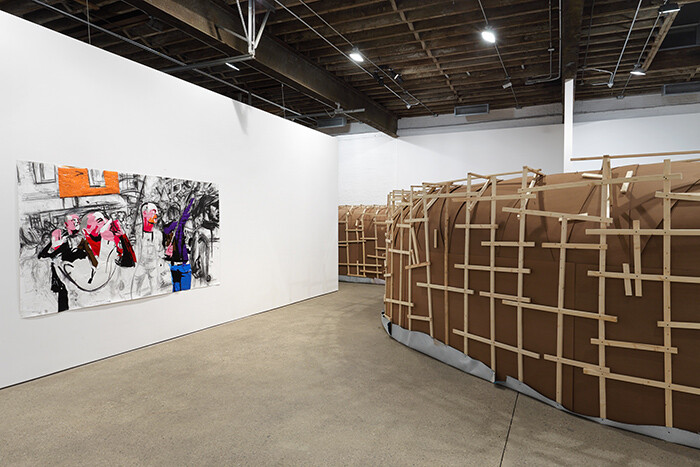It’s a bit like meeting a landmine that’s about to detonate. In his first solo show at Anton Kern, Erik van Lieshout explodes into our consciousness as a wild-child provocateur, a Pac-Man Expressionist running rampant 24/7, videotaping everything in his life, while making art out of every piece of paper, chunk of wood, sentence, gesture, fragment of material, conflict, situation, and mess that constitutes his—the contemporary artist’s—everyday life.
Provocation and agitation are his calling cards: two feet into the gallery’s threshold, the viewer is confronted with a looming, life-size tunnel hastily put together out of plywood and carpet, designed to mimic the basement of the St. Petersburg’s Hermitage where, for Manifesta 10 (in the summer of 2014) the artist and his team performed a two-month make-over for the museum’s 70 cats. (Since Empress Elizaveta Petrovna, the daughter of Peter the great, who ruled over Russia in the mid-eighteenth century, cats have lived in the basement of the museum in various states of care in order to rid the impeccable, imperial treasure house of mice and rats.) The tunnel leads to a cozy screening room where the 80-minute WORK (2015) is playing. Footage from Workers (2013) is fused and re-edited with footage from The Basement (2014), van Lieshout’s two previous project-dramas. A door crudely marked “EXIT” leads out of the ersatz theater to a small but powerful exhibition of charcoal drawings and stunning cut-vinyl tableaux-collages of street protests.
In WORK, we witness the many moments of this gifted binger’s hectic life and critical conscience, as he over-shares and shreds common codes of privacy, inhaling everything in sight in order to refashion it into commentary spoken through the persona of the artist as expulsive ego and brilliant jackass. Think Alfred Jarry meets Thomas Hirshhorn meets Ernie Kovacs meets Sacha Baron Cohen after they’ve attended the critical theory-based Whitney Independent Study Program (which the artist did actually attend in the 1990s). Here, he is a virtuoso bricoleur wielding everything at hand: animation, crudely fashioned props made of magazine collage and structures pasted with Xeroxed images on copy paper, and the camera itself—which van Lieshout hangs from the ceiling at one point and pushes like a child on a swing— arcs through the studio from the camera’s point of view, like some demented version of Michael Snow’s La Region Centrale (1971). A master of mise-en-scène, he films stunning meta-moments—like that of his sister and mother taking care of children with Down Syndrome, viewed in diegetic time and self-reflexively, as he cuts from these scenes to him sitting with an audience on a beach watching the very same footage on a screen propped on the sand.
Throughout WORK, he talks to himself and us and everyone around him as the narrative drifts from the early planning for the Venice Biennale where he will make “a new video work to be shown at a drive-in cinema”; to various conversations about idealism and utopia, the Russian Revolution, his “moralist” father’s training and subsequent abandonment of the priesthood; his own motivations and ideals as an artist; the suicide of his brother-in-law and his own ego and his family’s selfishness, staged in a carny stock prop of a painted gnome in the woods, into which he inserts his head and yells “I am doing penance!” A short scene of a trip to Tanzania to be with his mother, a social worker, includes a moment with a refugee from Sierra Leone who tells van Lieshout he refuses to mingle with others for fear of meeting the men who murdered his parents. Several scenes intervene as we circle back into conversations in his studio about the ethics of making art, a conversation with a man whose “work” is as a bank robber, cutting away at one point to a dying cockroach imprisoned in his studio (the girly scream he emits while catching it under a glass is worth the whole film), which he saves, leading to the last 20 minutes of the film, a recut version of the cat project, The Basement.
But this complex video (screened here for the first time) is only one part of the exhibition. With the charcoal drawings and freakishly colored cut-vinyl collages, we are witness to the transformation of the hilariously vulgar and inventive confessional critic into the alchemist who turns shit (charcoal and cut-vinyl) into gold. There are a few of the haunting charcoal drawings for which he first became known on display, but it is with the vinyl collages that he produces works of major emotional intensity. He “draws”/”paints” with scissors and cut-fragments of black, blue, and pink vinyl and slabs of paint like a punk Matisse crossed with Ernst Ludwig Kirchner and Otto Dix. The creation of space and layers of perspective are exquisitely rendered into representations of confrontation and strife transformed into visual explosions. Here, as in every aspect of this small but rigorous exhibition, the viewer is engulfed in a vortex of digestion and regurgitation where, as he says in The Basement: “It should stop being a project, it is real.” Meaning, as a project—two months of revamping the filthy quarters of the Hermitage basement where the cats live amid asbestos and their own shit —these are real cats and his solution is merely cosmetic—an artist’s dalliance. In the end, they still look terrified and in need of medical care, and the overwhelmed, penniless female volunteers, whispering “there is no money,” break our hearts. The director, who is not a cat person or dog person and doesn’t even like humans, tells van Lieshout, “It is illegal to use state funding to care for the cats.” He’d rather discuss Rembrandt.
Ever poking, ever gnawing, ever picking at the vulnerabilities of this mess we call art and life, this perpetual motion machine uses hilarity not moralism to confront the world. He may tell us “I want cheap provocation” but there’s nothing cheap in making us think. After all, the film reminds us that “Cats understand politics,” and so does van Lieshout.









